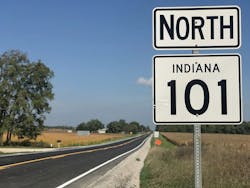There are only so many areas in the U.S. where transportation officials would need to consider accommodating horse-and-buggy traffic, but that was one of many factors taken into account when the Indiana Department of Transportation (INDOT) decided to widen an 8.6-mile stretch of S.R. 101 in Allen County, a corridor that branches off from U.S. 24.
Traversing mostly rural areas of the northwest Indiana county which includes Amish territory and plenty of farmland, the 22-ft-wide pavement along this segment of roadway was deemed by INDOT to be too small for modern traffic and too damaged for simple repair. Years of heavy truck and rural traffic had ruined the roadway, and the pavement needed to be widened for safety and capacity enhancement. Stripping and bottom-up cracking as well as surface delamination were observed in asphalt samples of the existing pavement, which averaged 10.3 in. of full-depth asphalt.
Recognizing the need for new pavement and a wider roadway, INDOT opted for a full-depth reclamation (FDR), using recycled material from the existing asphalt to rebuild the S.R. 101 pavement at reduced costs. While relying on recycled materials for paving is not a new approach for INDOT, the department did tackle a recycling process never previously attempted in the state—cold central plant recycling (CCPR). According to INDOT specs, CCPR consists of work involving a mixture of reclaimed asphalt pavement (RAP), millings from existing asphalt pavement or existing stockpiles, asphalt emulsion, water and other additives. The spec calls for the mixture to be processed at a nearby location, then placed and compacted to produce the recycled asphalt layer.
INDOT partnered with contractor Brooks Construction Inc. along with Specialties Co. as a subcontractor for the cement FDR to complete the project. The innovative approach to implement both FDR and CCP recycling techniques is what earned the S.R. 101 project a spot on this year’s Roads & Bridges/Asphalt Recycling and Reclaiming Association Recycling Awards list.
Considering traffic
S.R. 101 plays a major part in serving the steel companies in northern Indiana, an industry for which the state ranks No. 1 in the nation. The corridor serves as a trucking route for those companies to access U.S. 24, U.S. 30 and I-469. The route sees 2,000 AADT, 19% of which is trucks. This factor was one reason the project required widening from 22 ft to 26 ft.
“In addition to the trucks, it does also serve some of the Amish community,” Jason Wielinski, research manager with Heritage Research Group, an Asphalt Materials Inc. company, told Roads & Bridges. “So the safety perspective with the widening I think helps with a lot of the trucking that it sees, and then with some of the horse-and-buggy traffic that also traversed on that roadway.” The contractor estimated that work on this corridor included a 2- to 4-mile stretch that ran across Amish country.
Despite enforcing road closures for most of the corridor during construction, crews had to pave the two-lane roadway while accounting for local traffic from the various residents along S.R. 101. “One of the biggest headaches as far as maintenance of traffic would be that there’s probably 60 homes and businesses—farm businesses—on this route. So we had to have access for the homes throughout the whole project,” Jeff Austin, pavement and project technologist for Brooks Construction, told Roads & Bridges. “No matter where we were at, people had to get to their homes. That was probably the biggest challenge. We couldn’t truly close the road down.”
Crews did their best to communicate with residents who lived and worked along the corridor. “Our crews, as they were working, made sure they could flag folks around, made sure they weren’t driving through the cement and communicated with them when they were working in the areas of their homes,” Brad Schneider, vice president of Specialties Co., told Roads & Bridges.
In the mix
The CCPR specs from INDOT call for mandatory just-in-time training (JITT) for engineers and contractors to gain instruction from an experienced professional on the construction techniques, materials and test methods associated with asphalt emulsion stabilized CCPR.
“It gets everybody into the same room prior to the start of the recycling operations to go through the process,” Schneider said. “Some of these INDOT folks especially have never seen it before, so it gives you an opportunity to set expectations.”
The existing roadway included around 22 ft of asphalt with 2 ft of stone shoulders. The lift specs for the new pavement included 10 in. of cement FDR, 6 in. of compacted CCPR and 2 in. of 12.5-mm hot-mix asphalt (HMA) surface.
The cement FDR portion called for a 300-psi minimum specification. Around 18 locations were sampled with asphalt coring and shoulder material collection. The cement was laid on the remaining HMA base and subgrade while widening the roadway to 26 ft. Final mix designs required a 5% rate of cement application, and in the end, 118,235 sq yd of 10-in. FDR was completed utilizing 3,140 tons of portland cement from LafargeHolcim. Equipment used for the FDR process included Wirtgen W 120 & W 150 milling machines, Wirtgen WR 250 recyclers, a Caterpillar 140M grader, and Cat CP56 and CS56 rollers.
As the project began in June 2018, Brooks milled off 8 in. of asphalt at 20 ft wide, and the removed material was stockpiled for recycling into the CCPR mix. The remaining asphalt and shoulder material was spread into the cut utilizing a 4-in. milling machine. All of the remaining materials were then pulverized and graded prior to treatment with portland cement FDR at a 10 in. depth. “We utilized the shoulder material as part of the mix, so then it milled out the shoulders that were existing and put it back into the entire cross-section of the roadway prior to the cement FDR treatment to create a level, center-to-edge pavement section,” Schneider explained.
The mix for the project consisted of 100% RAP removed from the existing pavement on S.R. 101, which was crushed and screened to produce a continuously graded RAP material that was 100% passing the 1.25-in. sieve. An engineered emulsion for the job was manufactured by Asphalt Materials Inc.
The CCPR process involved crushing of the milled RAP to size, then feeding the material through a pugmill to mix with 2.5% engineered emulsion per the mix design requirements. Approximately 37,271 tons of CCPR mix was produced at roughly 300 tons per hour. Transporting the CCPR mix from the plant to the paving site would take an average of 20 minutes. “One of the challenges was just handling and processing 8 miles of milling,” Wielinski said. “That was a huge RAP pile. It was a great logistics challenge to get it out there, get it processed, get it through the pavement maintenance systems pugmill, coordinating the emulsion going onto it and getting those trucks out to the paving sites so they could lay it.”
The CCPR portion of the project took 17 days, with about a mile paved per day. The reclaimed CCPR mix was placed along S.R. 101 using a Cat 1055D paver, a Dynapac CC7200 smooth drum roller, a Bomag rubber-tired roller and a Hamm HD 120 vibratory smooth drum roller.
Before final paving, the CCPR material was profile milled to ensure grade and smoothness. After work with the CCPR mix was complete, the 2-in.-thick layer of 12.5-mm surface HMA was laid down, and stone shoulders were placed. A total of 15,763 tons of HMA was added to the surface. Work on S.R. 101 finished up in October 2018, about a month ahead of schedule.
Worth the effort
The team working with INDOT determined that use of the recycled asphalt materials resulted in around a 30% cost savings, and the final pavement structure is comprised of approximately 90% reused materials.
Specialties Co. had previously partnered with INDOT on at least three cement FDR projects, similar in scope to the work on S.R. 101, and the department has other recycling projects lined up for future completion. “INDOT, I think, has made an effort to make sure they identify roadways that would be candidates [for recycling], and investigate them before making a decision on reconstruction and resurface as well,” Schneider said.
For a project that implemented a recycling spec never before used on an INDOT jobsite, everyone involved appeared to be satisfied with the newly paved and widened S.R. 101 corridor. “Everyone I’ve spoken with on the project think it’s great,” Austin said. “It was long overdue, and I think they’re very happy with it.”
“I think for being the first [CCPR] job, all parties involved coordinated really well,” Wielinski added. “They took a new product and built a really good road.”



